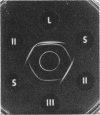Abstract
Lysates prepared from the amebocytes of Limulus polyphemus, the horseshoe crab, are gelled by endotoxin. Studies were carried out to characterize the components of amebocyte lysate and to examine the kinetics of their reaction with endotoxin. Analysis of amebocyte lysate using sucrose density gradients showed two peaks at 46% and 86% gradient volumes. G50 and G75 Sephadex column chromatography resulted in three protein peaks. One fraction contained a clottable protein, which had a molecular weight of approximately 27,000, and was heat stable. Another fraction contained a high molecular weight, heat labile material, which was activated by endotoxin and reacted with the clottable protein to form a gel. The rate of the reaction between endotoxin and amebocyte lysate was dependent upon the concentration of endotoxin and the concentration of the fraction containing the high molecular weight material. The activity of this fraction was inhibited by diisopropyl fluorophosphate, parachloromercuribenzoate, and para-chloromercuriphenyl sulfonate, suggesting that enzymatic activity depended upon serine hydroxyl and sulfhydryl groups. The reaction between endotoxin and the fractions of lysate was temperature and pH dependent. The data suggest that endotoxin activates an enzyme which then gels the clottable protein contained in amebocyte lysate.
Full text
PDF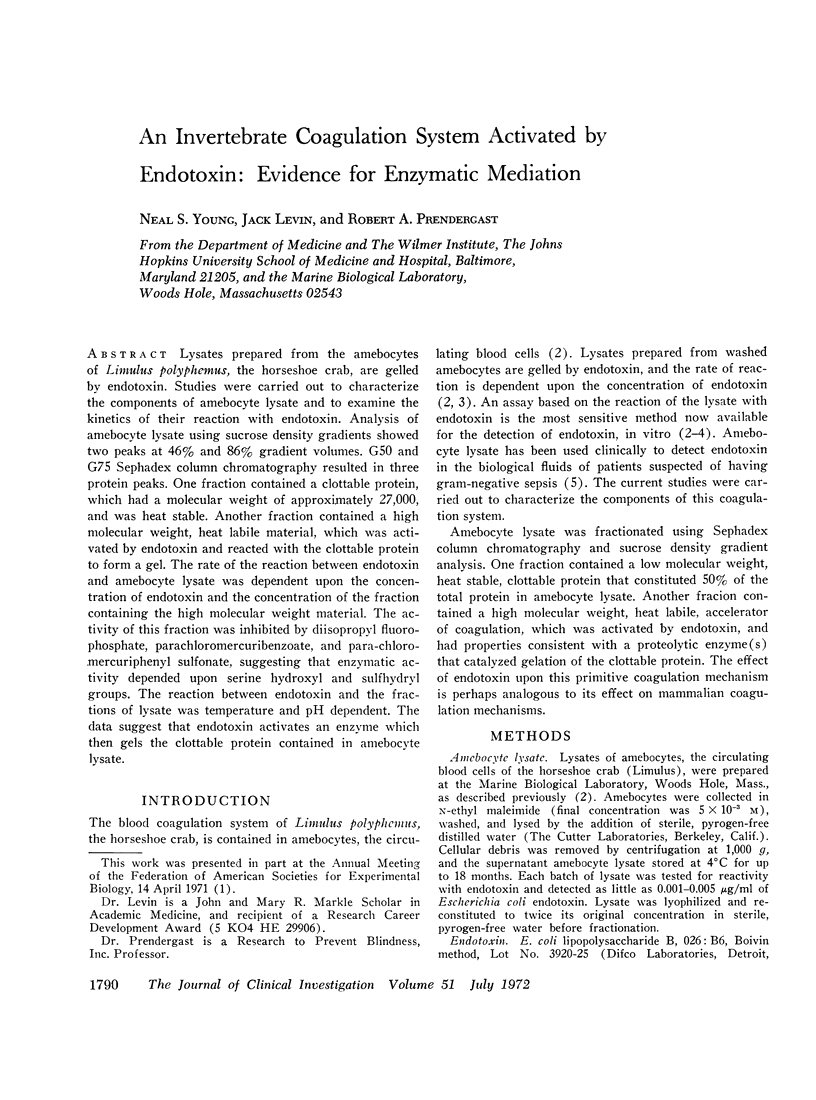
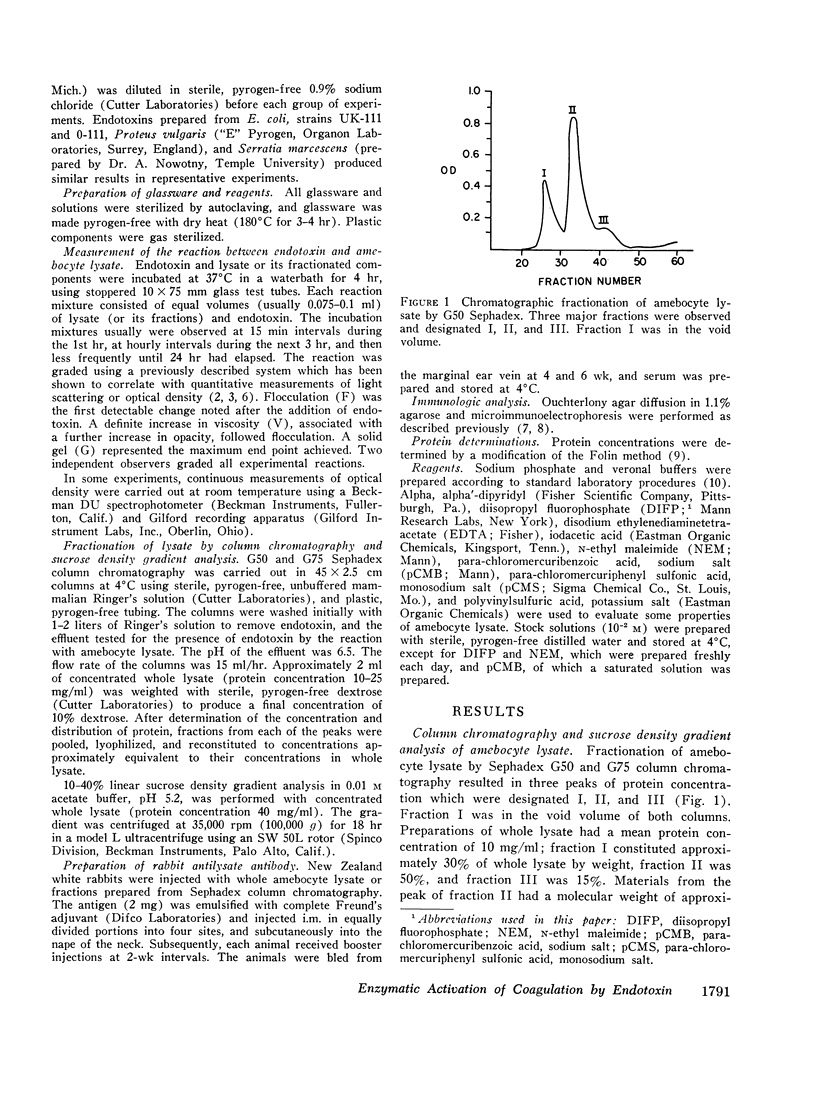
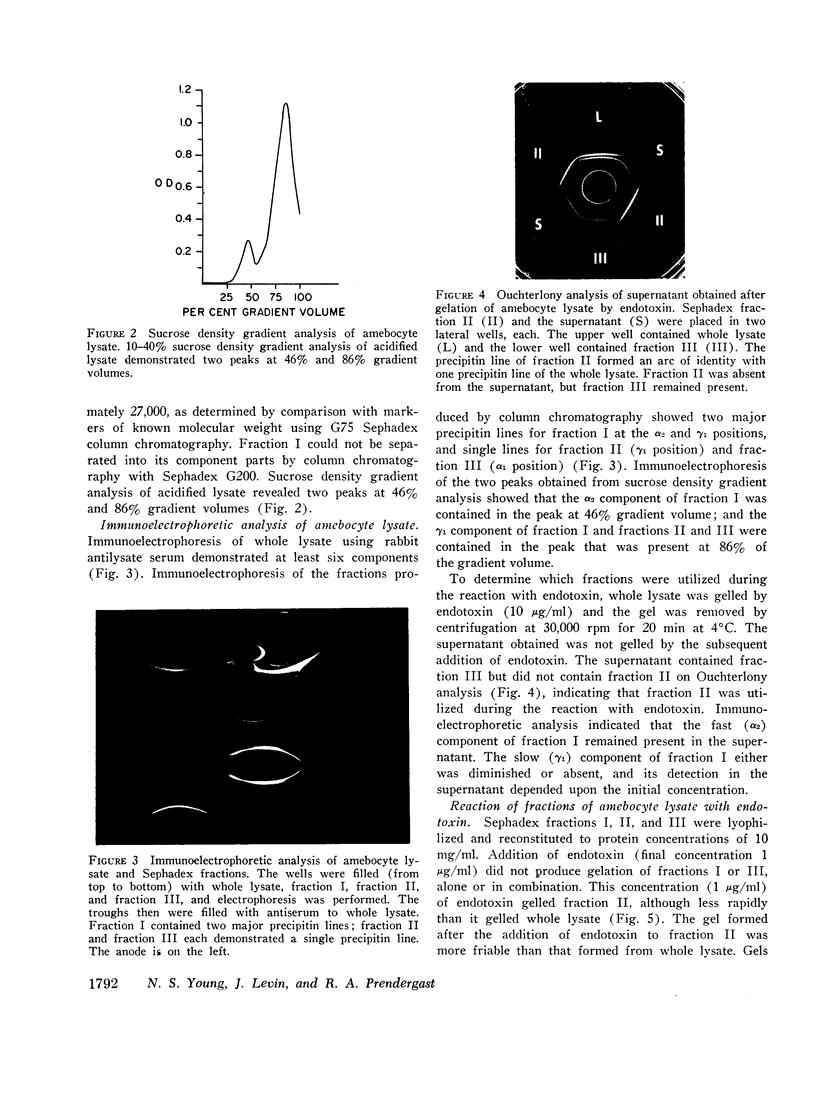
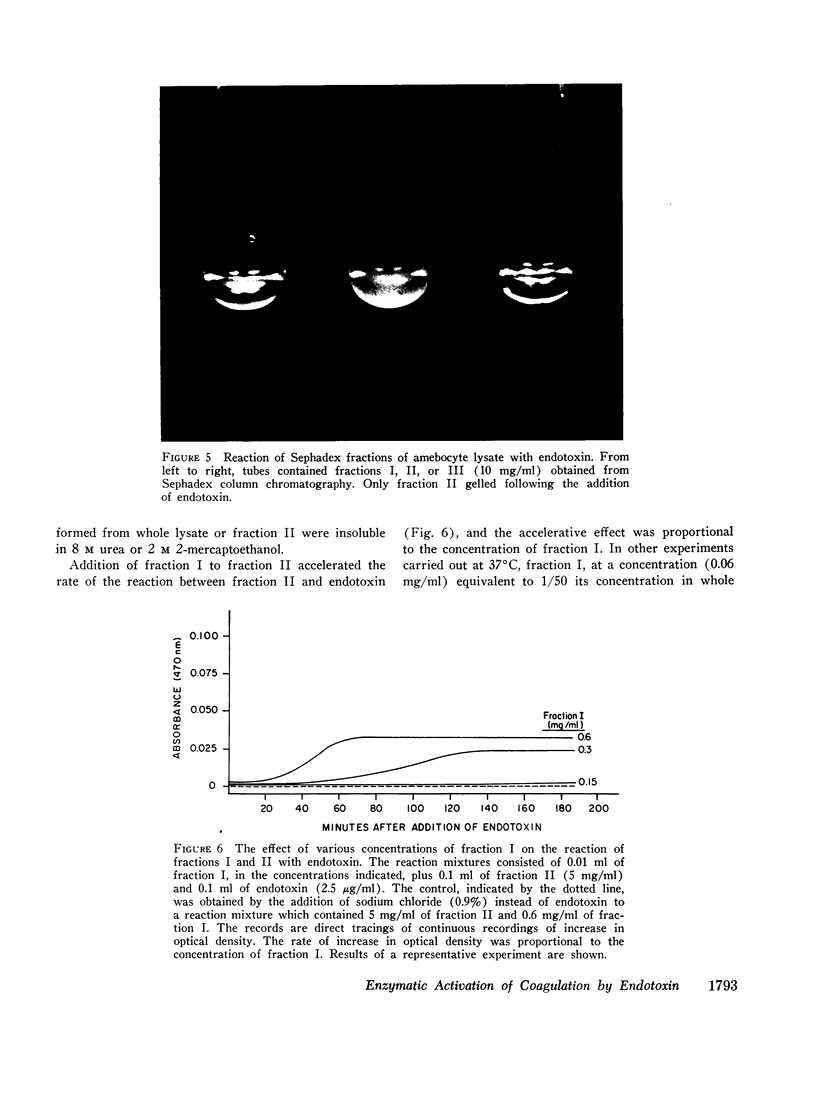
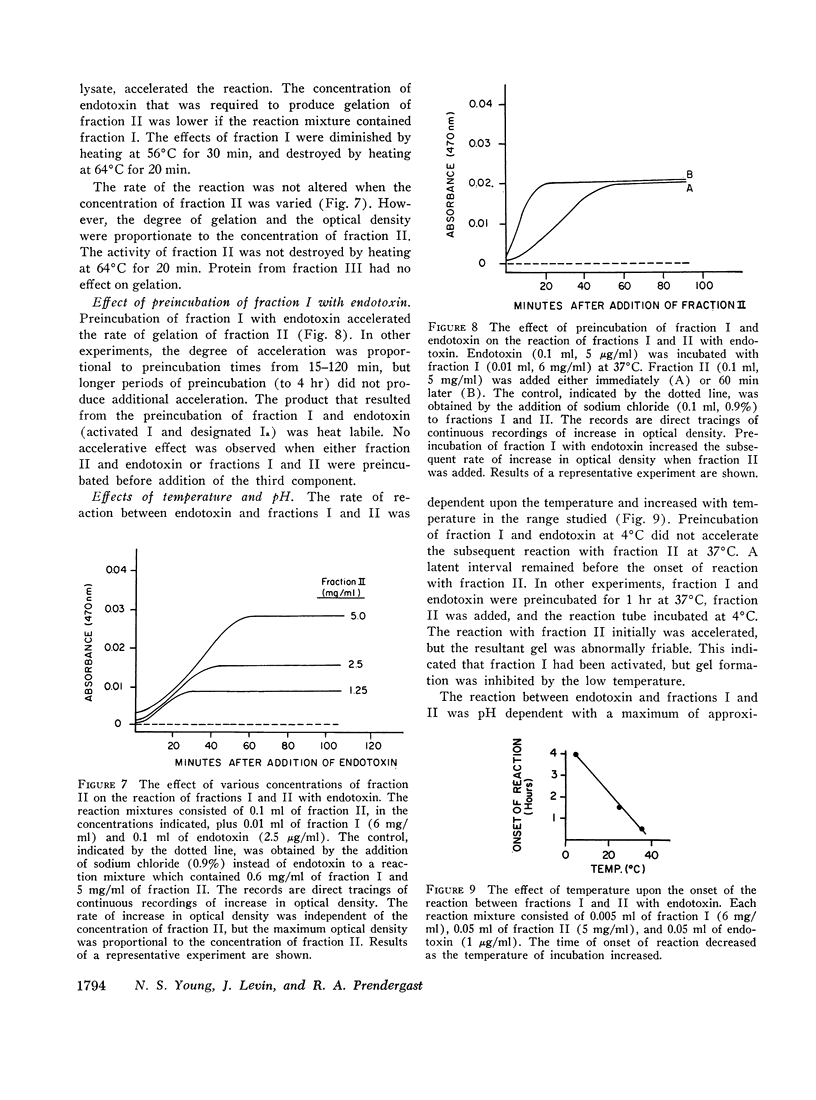
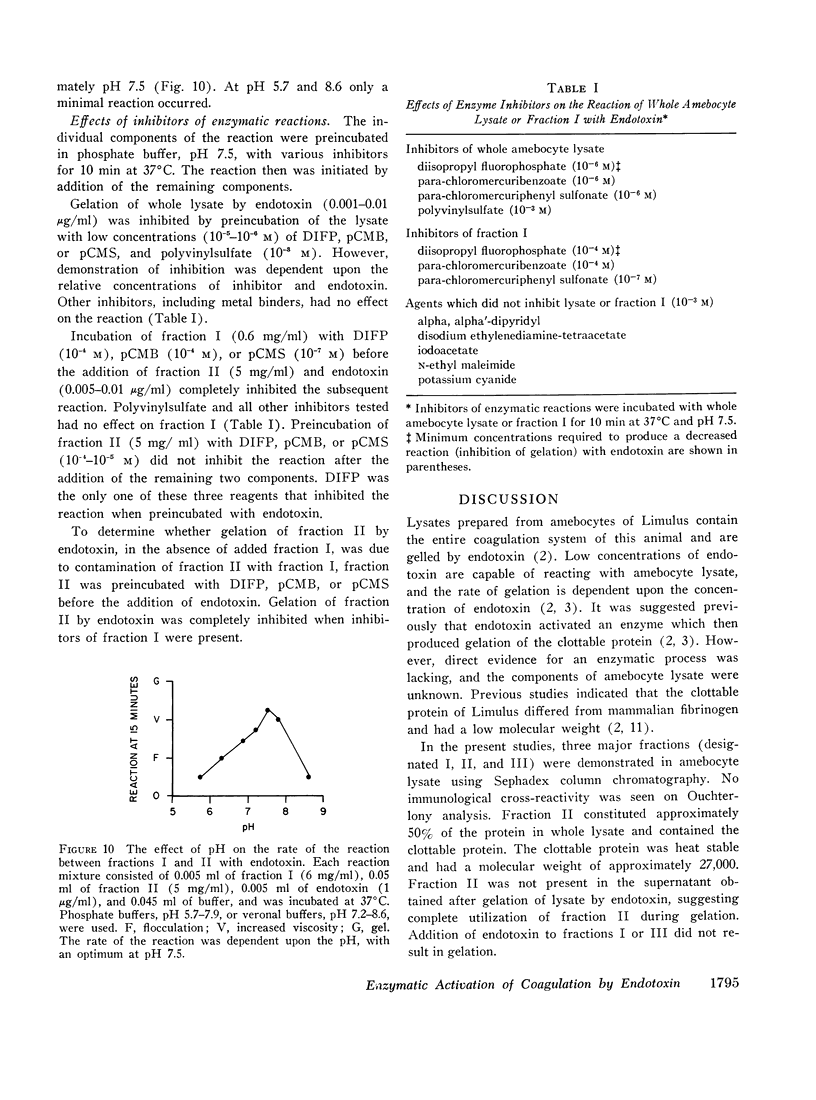
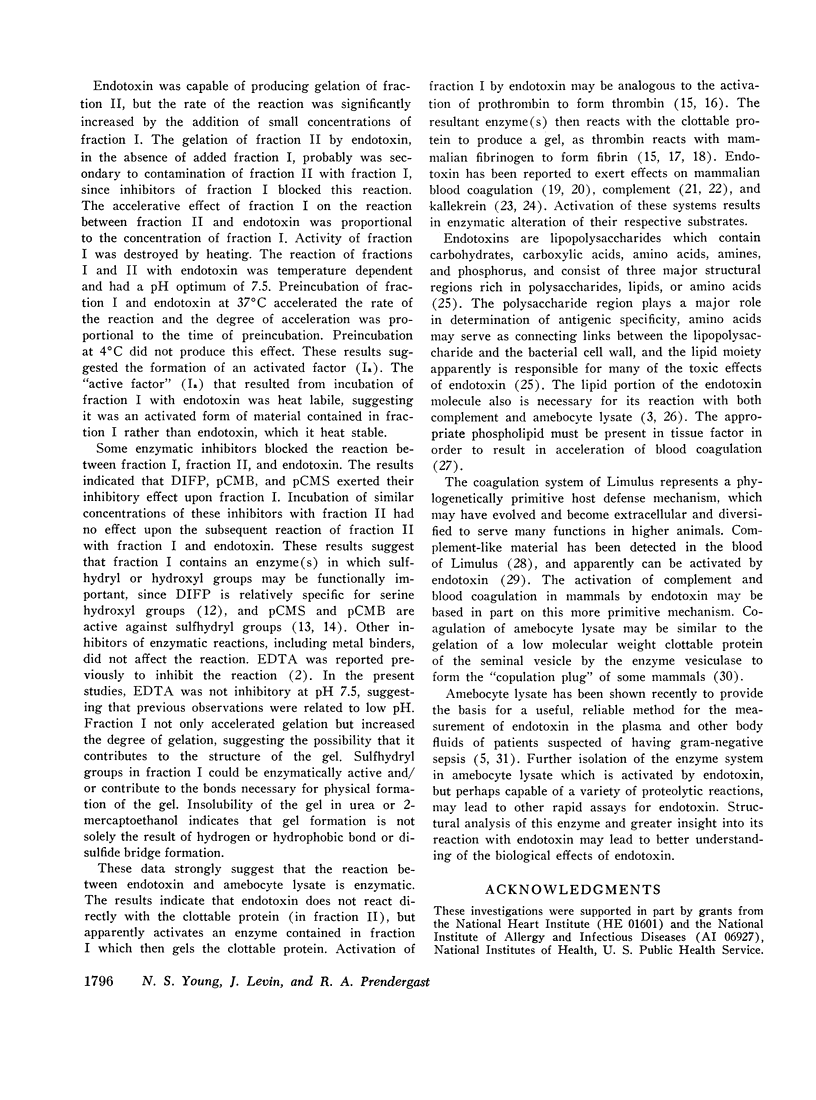
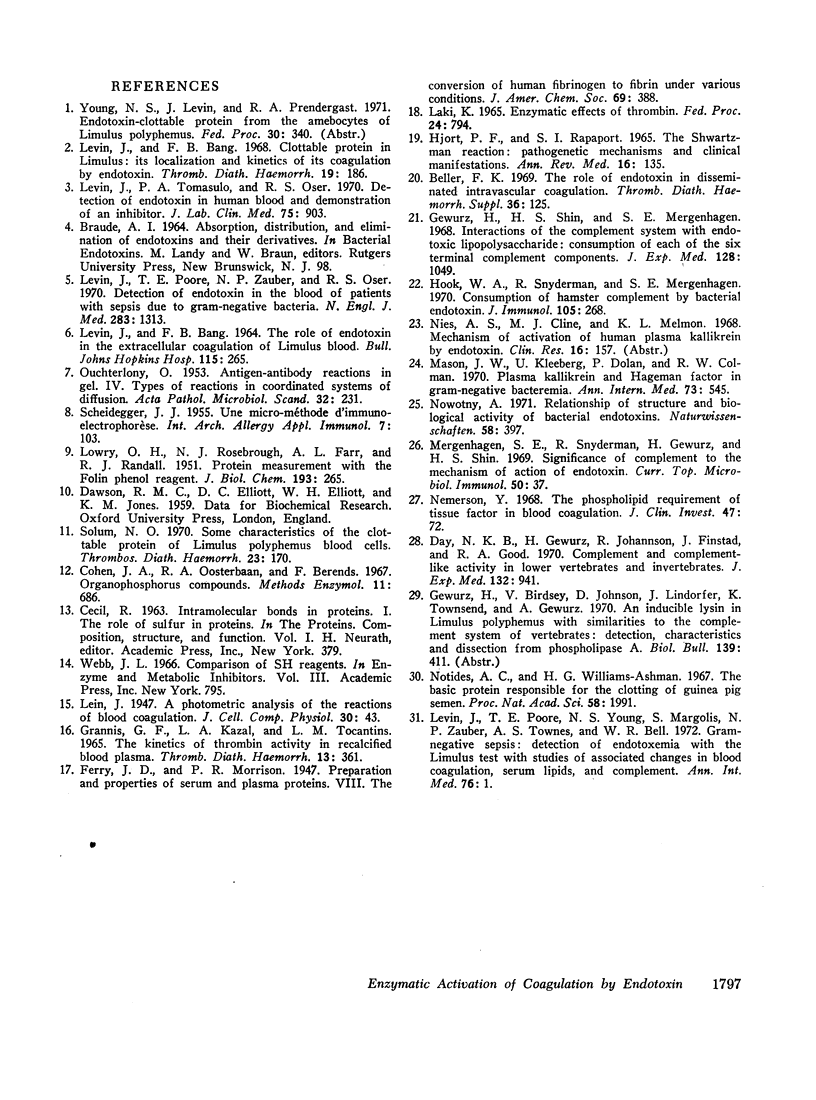
Images in this article
Selected References
These references are in PubMed. This may not be the complete list of references from this article.
- Beller F. K. The role of endotoxin in disseminated intravascular coagulation. Thromb Diath Haemorrh Suppl. 1969;36:125–149. [PubMed] [Google Scholar]
- Day N. K., Gewurz H., Johannsen R., Finstad J., Good R. A. Complement and complement-like activity in lower vertebrates and invertebrates. J Exp Med. 1970 Nov;132(5):941–950. doi: 10.1084/jem.132.5.941. [DOI] [PMC free article] [PubMed] [Google Scholar]
- GRANNIS G. F., KAZAL L. A., TOCANTINS L. M. THE KINETICS OF THROMBIN ACTIVITY IN RECALCIFIED BLOOD PLASMA. Thromb Diath Haemorrh. 1965 Jun 15;13:361–372. [PubMed] [Google Scholar]
- Gewurz H., Shin H. S., Mergenhagen S. E. Interactions of the complement system with endotoxic lipopolysaccharide: consumption of each of the six terminal complement components. J Exp Med. 1968 Nov 1;128(5):1049–1057. doi: 10.1084/jem.128.5.1049. [DOI] [PMC free article] [PubMed] [Google Scholar]
- HJORT P. F., RAPAPORT S. I. THE SHWARTZMAN REACTION: PATHOGENETIC MECHANISMS AND CLINICAL MANIFESTATIONS. Annu Rev Med. 1965;16:135–168. doi: 10.1146/annurev.me.16.020165.001031. [DOI] [PubMed] [Google Scholar]
- Hook W. A., Snyderman R., Mergenhagen S. E. Consumption of hamster complement by bacterial endotoxin. J Immunol. 1970 Jul;105(1):268–270. [PubMed] [Google Scholar]
- LEVIN J., BANG F. B. THE ROLE OF ENDOTOXIN IN THE EXTRACELLULAR COAGULATION OF LIMULUS BLOOD. Bull Johns Hopkins Hosp. 1964 Sep;115:265–274. [PubMed] [Google Scholar]
- LOWRY O. H., ROSEBROUGH N. J., FARR A. L., RANDALL R. J. Protein measurement with the Folin phenol reagent. J Biol Chem. 1951 Nov;193(1):265–275. [PubMed] [Google Scholar]
- Laki K. Enzymatic effects of thrombin. Fed Proc. 1965 Jul-Aug;24(4):794–799. [PubMed] [Google Scholar]
- Levin J., Bang F. B. Clottable protein in Limulus; its localization and kinetics of its coagulation by endotoxin. Thromb Diath Haemorrh. 1968 Mar 31;19(1):186–197. [PubMed] [Google Scholar]
- Levin J., Poore T. E., Young N. S., Margolis S., Zauber N. P., Townes A. S., Bell W. R. Gram-negative sepsis: detection of endotoxemia with the limulus test. With studies of associated changes in blood coagulation, serum lipids, and complement. Ann Intern Med. 1972 Jan;76(1):1–7. doi: 10.7326/0003-4819-76-1-1. [DOI] [PubMed] [Google Scholar]
- Levin J., Poore T. E., Zauber N. P., Oser R. S. Detection of endotoxin in the blood of patients with sepsis due to gran-negative bacteria. N Engl J Med. 1970 Dec 10;283(24):1313–1316. doi: 10.1056/NEJM197012102832404. [DOI] [PubMed] [Google Scholar]
- Levin J., Tomasulo P. A., Oser R. S. Detection of endotoxin in human blood and demonstration of an inhibitor. J Lab Clin Med. 1970 Jun;75(6):903–911. [PubMed] [Google Scholar]
- Mason J. W., Kleeberg U., Dolan P., Colman R. W. Plasma kallikrein and Hageman factor in Gram-negative bacteremia. Ann Intern Med. 1970 Oct;73(4):545–551. doi: 10.7326/0003-4819-73-4-545. [DOI] [PubMed] [Google Scholar]
- Mergenhagen S. E., Snyderman R., Gewurz H., Shin H. S. Significance of complement to the mechanism of action of endotoxin. Curr Top Microbiol Immunol. 1969;50:37–77. doi: 10.1007/978-3-642-46169-9_2. [DOI] [PubMed] [Google Scholar]
- Nemerson Y. The phospholipid requirement of tissue factor in blood coagulation. J Clin Invest. 1968 Jan;47(1):72–80. doi: 10.1172/JCI105716. [DOI] [PMC free article] [PubMed] [Google Scholar]
- Notides A. C., Williams-Ashman H. G. The basic protein responsible for the clotting of guinea pig semen. Proc Natl Acad Sci U S A. 1967 Nov;58(5):1991–1995. doi: 10.1073/pnas.58.5.1991. [DOI] [PMC free article] [PubMed] [Google Scholar]
- Nowotny A. Relationship of structure and biological activity of bacterial endotoxins. Naturwissenschaften. 1971 Aug;58(8):397–409. doi: 10.1007/BF00591520. [DOI] [PubMed] [Google Scholar]
- SCHEIDEGGER J. J. Une micro-méthode de l'immuno-electrophorèse. Int Arch Allergy Appl Immunol. 1955;7(2):103–110. [PubMed] [Google Scholar]
- Solum N. O. Some characteristics of the clottable protein of limulus polyphemus blood cells. Thromb Diath Haemorrh. 1970 Feb 28;23(1):170–181. [PubMed] [Google Scholar]



